
Puja is a worship ritual performed by Hindus to offer devotional homage and prayer to one or more deities, to host and honour a guest, or to spiritually celebrate an event. It may honour or celebrate the presence of special guests, or their memories after they die. The word puja is roughly translated into English as 'reverence, honour, homage, adoration, or worship'. Puja, the loving offering of light, flowers, and water or food to the divine, is the essential ritual of Hinduism. For the worshipper, the divine is visible in the image, and the divinity sees the worshipper. The interaction between human and deity, between human and guru, is called a Darshanam.

The Sabarimala Sree Dharma Sastha Temple is a Hindu temple dedicated to the god Ayyappan, who is also known as Dharma Shasta and is the son of the deities Shiva and Mohini.
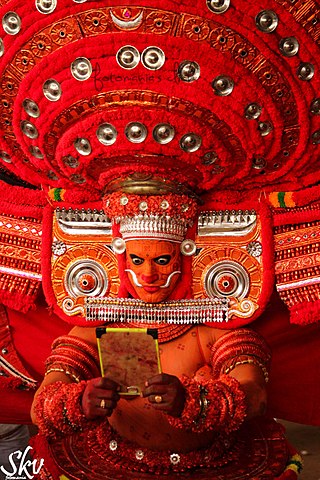
Theyyam is a Hindu religious ritual practiced in northern Kerala and some parts of Karnataka. Theyyam is also known as Kaḷiyāṭṭaṁ or Tiṟa. Theyyam consists of traditions, rituals and customs associated with temples and sacred groves of Malabar. The people of the region consider Theyyam itself as a channel to a god and they thus seek blessings from Theyyam.
Kunnathur Padi is the historic center for the folk Hindu deity Sree Muthappan. The center stands in Payyavoor Grama Panchayat, Kannur District of the Kerala state of India, 3,000 feet above sea level, on top of Udumbumala in the Sahyadri mountains. The region belonged to the kingdom of the Mannanar dynasty, the line of Muttappan. In 1902, Kunhikelapan Mannanar, the last king of this dynasty of Muthappan's clan, was killed and the British government seized the property of this dynasty, and Karakattidam Nayanar, a Nair landlord, got the right to manage Kunnathur Padi.

Achankovil is a 128 km (80 mi) long west flowing river in Kerala, India. It flows through the districts of Kollam, Pathanamthitta and Alappuzha. The river drains vast tract of fertile plains of Upper Kuttanad in the Alappuzha and Pathanamthitta districts. It also sustains numerous urban settlements along its course such as Konni, Pathanamthitta, Pandalam and Mavelikkara.

The Aranmula Parthasarathy Temple is a Hindu temple located in Aranmula, a village in Pathanamthitta District, Kerala, South India, on the southern bank of Pamba river, the third longest river in Kerala. It is dedicated to the Lord Krishna, who is worshipped as Parthasarathy. Constructed in the Kerala style of architecture, it is one of the "Divya Desams", the 108 temples of Vishnu revered by the Alvar saints.

Aryankavu is a village located in the Kollam district of the Indian state of Kerala. It lies close to the border between Kerala and Tamil Nadu near Thenmala. It is also one of the famous pilgrimage sites associated with the legend of Sabarimala. The village is located beside Shendurney Wildlife Sanctuary.
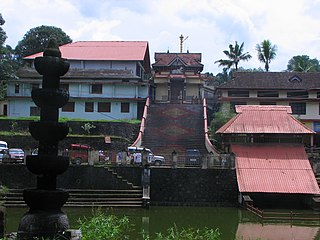
Chirakkadavu Mahadevar Temple is a Hindu temple located at Chirakkadavu in Kottayam, Kerala and is situated between the Kollam-Theni route of the National Highway 183, about 32 km east of the Akshra Nagari, Kottayam city and 3 km south of Ponkunnam en route to Manimala and Erumely.
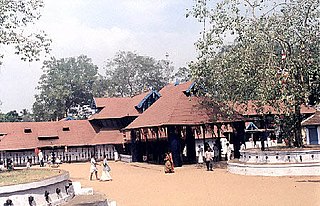
Sree Kurumba Bhagavati Temple is a Hindu temple at Kodungallur, Thrissur District, Kerala state, India. It is dedicated to the goddess Bhadrakali, a form of Mahakali or simply Durga or Aadi Parashakthi or Bhuvaneshwari or Kannagi worshipped and significantly revered in Kerala. The goddess is known also by the names "Sri Kurumba"". This temple is the head of 64 Bhadrakali temples in Kerala. This Mahakali temple is one of the oldest functioning temples in India. The goddess of the temple represents the goddess in her fierce ('ugra') form, facing North, featuring eight hands with various attributes. One is holding the head of the demon king Daruka, another a sickle-shaped sword, next an anklet, another a bell, among others.
Hinduism, Islam and Christianity are the prominent religions in Kollam district. As per the Census 2011, out of the total population of 2,635,375 persons, 64.42% follow Hinduism, 19.30% follow Islam and 16.00% follow Christianity. Other religions comprise 0.04%, while 0.25% did not state any religion.

Asramam Sree Krishna Swamy Temple is a Sreekrishna temple in the district of Kollam, Kerala, South India located on the shores of Ashtamudi Lake. Lord Krishna in the form of Navaneet Krishnan or Krishna with Butter is worshiped here. The temple sits on the top of a mount created by digging earth from a nearby place, which now forms the temple pond.

Punthalathazham is a landlocked neighbourhood of the city of Kollam in the Indian state of Kerala. It is located around six kilometres east of the core Kollam (Quilon) city towards Kannanalloor . This place has a little geographical importance and serves as the tail boundary of Kollam Municipal Corporation. Inhabitants belong to working and middle classes.
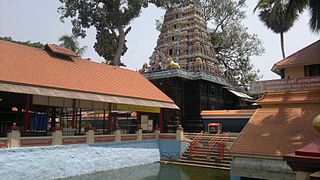
Karikkakom Sree Chamundi Devi Temple or Karikkakom Devi Temple is a temple to three Hindu goddess Chamundi located in Thiruvananthapuram, India at Karikkakom. It is more than 600 years old and enshrines a Panchaloha idol of the goddess Karikkakathamma – an incarnation of Chamundi. Chamundi Devi is worshiped there in three different forms: Maha Chamundi, Raktha Chamundi, and Bala Chamundi.
Rajah Annamalaipuram Ayyappan Koil is a Hindu temple dedicated to the deity Ayyappa in Chennai, India. It is located at Raja Annamalaipuram, a coastal neighbourhood of Chennai.

Chengannur Mahadeva Temple is a prominent Hindu temple, dedicated to Shiva and located in the town of Chengannur in the South Indian state of Kerala. The temple is one of the major Shiva temples in Kerala, along with the Ettumanoor Mahadevar Temple, Kaduthruthy Mahadeva Temple, Vaikom Temple, Ernakulam Shiva Temple and Vadakkunnathan Temple. goddess Parvati is worshipped with equal importance.There are shrines for Ganesha, Dakshinamurti, Subrahmanya, Shasta, Krishna, Nilagriva, Sthalisha, Hanuman, Ganga, and serpent deities inside and outside the temple complex.

Pandalam dynasty a royal dynasty emerged from a branch of Pandya kingdom. which existed in Kerala during the Kollam era.
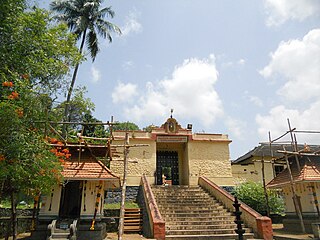
The Achankovil Sastha Temple is a Hindu temple located near the banks of the Achankovil River in the Kollam district in the Indian state of Kerala. It is one of the five important temples dedicated to Shasta in Kerala, the others being Kulathupuzha, Aryankavu, Sabarimala and Kanthamala. The idol in the temple is believed to have been consecrated by Parashurama. The temple is known for curing poisonous snakebites. The Travancore Devaswom Board administers the temple.

The Aryankavu Sastha Temple is a Hindu temple located in Aryankavu in the Kollam district of the Indian state of Kerala. It is one of the five major temples dedicated to Shasta in Kerala, the others being Kulathupuzha, Achankovil, Sabarimala and Kanthamala. The temple's idol is believed to have been consecrated by Parashurama. The temple is governed by the Travancore Devaswom Board.

Sabarimala Temple is a hindu temple dedicated to Shasta, in Pathanamthitta District, Kerala, India. Women and girls of reproductive age have traditionally not been permitted to worship there, as Shasta is a celibate deity. The Kerala high court provided a legal justification for this tradition, and since 1991 onwards, women and girls were legally forbidden to enter the temple.
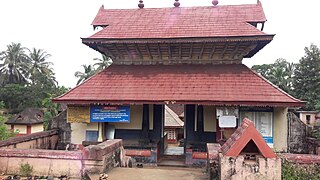
Sree Madiyan Koolom Temple is located near Kanhangad in the Indian state of Kerala. It is one of the most prominent Hindu temples in Kasargod district, and is some 500 years old. It is dedicated to deity Kshetrapalakan Eswaran, the mother Goddess known as Kalarathri Amma (Bhadrakali).
















